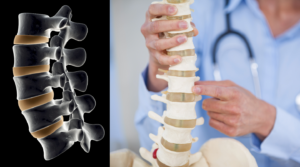Maintaining a Healthy Lumbar Spine: Tips for a Pain-Free Back
The lumbar spine in the lower back region of the human body plays a crucial role in supporting the body’s weight, facilitating movement, and protecting the delicate spinal cord. However, due to our sedentary lifestyles, poor posture, lack of awareness, injuries, deformities, wear & tear, aging, etc., the health of the lumbar spine of many individuals erodes and they face lower back pain issues. In cases where physical therapy and other non-surgical treatments don’t work, surgeons opt for spinal fusion surgery where they insert a lumbar cage to stabilize the spine and alleviate pain.
Spinal fusion surgeries using lumbar cages have a high success rate and help improve the quality of life of the patient. However, lumbar fusion surgeries have an extended recovery period since the lumbar spine is actually not fused immediately after the surgery. The bone graft or substitute requires 3-6 months to grow back and immobilize the spine. Until then, the lumbar spine cage will provide support and stabilize the lower back region until the bone grows and heals.
During this post-operative period and recovery stages, patients must take good care of themselves and the lumbar cage to ensure a healthy back and become pain-free in the long run. In this blog, we help you understand how to maintain a healthy lumbar spine and become back pain-free.
Understanding The Lumbar Cage
Lumbar cage, also known as lumbar interbody cage or lumbar spine cage, is a spinal implant used in fusion surgeries in the lumbar spine. In these lumbar fusion procedures, surgeons place the spine cage in between two or more adjacent vertebrae in the lumbar spine to stabilize and alleviate pain caused by various spinal conditions such as degenerative disc disease, spinal stenosis, tumors, fractures, spondylolisthesis, and other spinal instabilities.
The Design
Lumbar cages are typically made with surgery-grade titanium or performance polymers such as PEEK. Why? Because these materials are sturdy, durable, and do not crumble under the mechanical load of the body. They are biocompatible and don’t interact with the bodily fluids and corrode, ensuring patient safety.
Lumbar cages are hollow cylindrical structures with a large graft window in the center. They are available in varying sizes, shapes, and heights to cater to the varying surgical needs. They can also be 3D-printed in cases where the patient has a unique anatomical structure to ensure proper fit and ensure better spinal fusion.
Functions and Benefits of Lumbar Cages
The main purpose of the lumbar cage is to immobilize the spine, providing support and stability to the lower back region. It is used to restore the height between two adjacent vertebrae in the lumbar region to their original intervertebral disc height. They also help to restore the natural curve of the lumbar spine.
Lumbar spine cages serve as support structures while fusion occurs by creating space for the bone graft/ substitute to fuse, grow, and heal properly. Lumbar cages help decompress nerves and relieve stress by expanding the bony openings between the vertebra and creating greater space for nerve roots.
Unlocking the Secrets to a Pain-Free Lumbar Spine After Surgery
Lumbar spinal fusion surgery, where a lumbar cage is placed between the adjacent vertebrae after discectomy, is known to be effective in providing stability to the patient’s spine and helping improve their lower back health. However, the complete fusion of the bone and healing takes 3-6 months. In the post-operative phase and even after the bone completely fuses, patients must take some steps to ensure long-term benefits and a pain-free back. Here, we discuss tips for the post-operative stages and the long-term changes that patients should make.
Hospital Stay & Immediate Recovery: In this stage, the patient is still in the hospital and is typically given medication to ease the pain and is closely monitored. Incision care is essential to keep the wound dry and clean, preventing risks of infection and other complications. For the first few days, showers are prohibited, and the patient is suggested to only take sponge baths to keep the wound clean and dry.
Physical & Occupational Therapy: Physical and occupational therapists, in the immediate period after surgery, teach patients how to sit, stand, walk, engage in self-care activities, and do other regular activities without straining their back. This is essential to ensure that the recovery is not disrupted, and excessive loads are not put over the lumbar cage.
After the initial few days or weeks, the physical therapist will teach exercises and activities, tailored to the patient’s condition, to help strengthen their core muscles and the lower back, ensure proper body mechanics, improve mobility, and prevent further complications. It is critical that patients regularly go to physical therapy and perform prescribed activities to ensure smoother recovery and long-term benefits.
Activity Restrictions: The doctors and physical therapists will place activity restrictions such as heavy lifting, twisting, strenuous bending, etc. on the patients to ensure that the lumbar cage and the spine aren’t overworked or overloaded in the recovery period. It is important to follow these instructions carefully to ensure proper, swifter recovery and minimize chances of implant failure and complications.
Diet and Nutrition: Maintaining a well-balanced diet rich in nutrients, particularly calcium and vitamin D, to ensure proper recovery after the lumbar spinal procedure. Malnutrition not only slows down recovery but also causes the recurrence of lower back pain.
Health Management: Health conditions such as diabetes, osteoporosis, depression, and chronic illnesses slow down the recovery process as do obesity and a sedentary lifestyle. Patients must manage their health properly and maintain healthy body weight to ensure proper recovery and a pain-free back in the long run.
Quit Smoking as smoking impedes the recovery process.
Long-Term Weight Management: Excess body weight can contribute to lumbar spine issues and cause problems to the lumbar cage. Adopting a healthy diet and engaging in regular physical activity can help maintain an optimal weight, thereby reducing the strain on the lower back after recovery as well.
Adopt a Healthier Lifestyle: After rehabilitation and recovery, it is key to adopt a healthier lifestyle to ensure good spine health in the long run. You should work on your posture, maintain an active lifestyle with ample physical activity, have an ergonomic work space, and maintain proper physical and mental health.
Conclusion
A healthy lumbar spine is fundamental to overall well-being, affecting everything from posture and mobility to pain prevention. Follow these tips to maintain a healthy lower back.
Gesco offers a range of spine cages, including superior-quality, precise, and durable lumbar cages. Visit website now.


